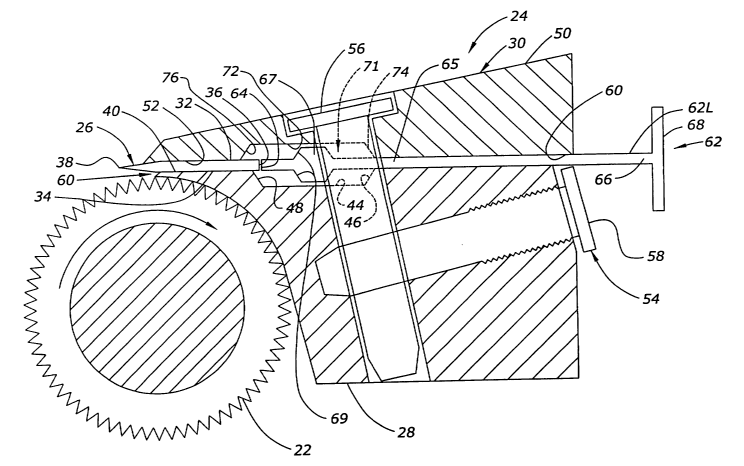Some of the information on this Web page has been provided by external sources. The Government of Canada is not responsible for the accuracy, reliability or currency of the information supplied by external sources. Users wishing to rely upon this information should consult directly with the source of the information. Content provided by external sources is not subject to official languages, privacy and accessibility requirements.
Any discrepancies in the text and image of the Claims and Abstract are due to differing posting times. Text of the Claims and Abstract are posted:
| (12) Patent: | (11) CA 2403789 |
|---|---|
| (54) English Title: | MEANS FOR REMOTELY EJECTING THE BLADE OF A MEAT SKINNING MACHINE |
| (54) French Title: | MOYENS POUR EJECTER A DISTANCE LA LAME D'UNE MACHINE DE DECOUENNAGE DE VIANDE |
| Status: | Deemed expired |
| (51) International Patent Classification (IPC): |
|
|---|---|
| (72) Inventors : |
|
| (73) Owners : |
|
| (71) Applicants : |
|
| (74) Agent: | RIDOUT & MAYBEE LLP |
| (74) Associate agent: | |
| (45) Issued: | 2005-04-05 |
| (86) PCT Filing Date: | 2001-06-29 |
| (87) Open to Public Inspection: | 2002-08-15 |
| Examination requested: | 2002-08-13 |
| Availability of licence: | N/A |
| (25) Language of filing: | English |
| Patent Cooperation Treaty (PCT): | Yes |
|---|---|
| (86) PCT Filing Number: | PCT/US2001/041209 |
| (87) International Publication Number: | WO2002/062148 |
| (85) National Entry: | 2002-08-13 |
| (30) Application Priority Data: | ||||||
|---|---|---|---|---|---|---|
|
A mechanism for ejecting a cutting blade from a knife assembly in a meat
skinning machine includes a shoe with a
supporting surface for the blade and a releasable clamping assembly for
clamping the cutting blade to the supporting surface. The
clamping assembly includes a clamp and releasable fasteners. Together the shoe
and clamp form an elongated open slot adjacent
to the blade when clamped together by the fasteners. A pair of ejectors extend
into the slot and are slidably mounted with respect
to the shoe and the clamp so as to engage the blade. The ejectors can be
pushed into the blade to eject the blade when the clamp
is released. The ejectors are rigid elongated rods longitudinally spaced along
the edge of the blade opposite the cutting edge. The
ejector rods include a guide bulb thereon, with cam surfaces thereon to engage
and lift the clamp when moved rearwardly to lift the
loosened clamp from the blade.
La présente invention concerne un mécanisme d'éjection d'une lame tranchante (26) d'un ensemble couteaux dans une machine de découennage de viande comprend un patin (28) avec une surface support (40) pour la lame et un ensemble de serrage (30) amovible permettant de serrer la lame tranchante sur la surface support. L'ensemble de serrage comprend une patte de serrage (50) et des fermoirs amovibles. Le patin ainsi que la patte de serrage forment une encoche ouverte (60) allongée adjacente à la lame lors du serrage au moyen des fermoirs. Une paire d'éjecteurs (62) s'étendent dans l'encoche et sont montés coulissant par rapport au patin et à la patte de serrage de manière à être en contact avec la lame. Les éjecteurs peuvent être poussés contre la lame pour éjecter la lame lorsque la patte de serrage est desserrée. Les éjecteurs sont des tiges allongées, rigides, longitudinalement espacées le long du bord de la lame opposée au bord tranchant. Les tiges d'éjection comprennent une ampoule guide (67) présentant des surfaces de came (69) venant en contact avec la patte de serrage et la soulevant lors du déplacement vers l'arrière de manière à soulever la patte de serrage desserrée par rapport à la lame.
Note: Claims are shown in the official language in which they were submitted.
Note: Descriptions are shown in the official language in which they were submitted.

For a clearer understanding of the status of the application/patent presented on this page, the site Disclaimer , as well as the definitions for Patent , Administrative Status , Maintenance Fee and Payment History should be consulted.
| Title | Date |
|---|---|
| Forecasted Issue Date | 2005-04-05 |
| (86) PCT Filing Date | 2001-06-29 |
| (85) National Entry | 2002-08-13 |
| Examination Requested | 2002-08-13 |
| (87) PCT Publication Date | 2002-08-15 |
| (45) Issued | 2005-04-05 |
| Deemed Expired | 2008-06-30 |
There is no abandonment history.
| Fee Type | Anniversary Year | Due Date | Amount Paid | Paid Date |
|---|---|---|---|---|
| Request for Examination | $400.00 | 2002-08-13 | ||
| Registration of a document - section 124 | $100.00 | 2002-08-13 | ||
| Application Fee | $300.00 | 2002-08-13 | ||
| Maintenance Fee - Application - New Act | 2 | 2003-06-30 | $100.00 | 2003-05-14 |
| Maintenance Fee - Application - New Act | 3 | 2004-06-29 | $100.00 | 2004-05-14 |
| Final Fee | $300.00 | 2005-01-17 | ||
| Maintenance Fee - Patent - New Act | 4 | 2005-06-29 | $100.00 | 2005-05-13 |
| Maintenance Fee - Patent - New Act | 5 | 2006-06-29 | $200.00 | 2006-05-05 |
| Registration of a document - section 124 | $100.00 | 2006-06-29 |
Note: Records showing the ownership history in alphabetical order.
| Current Owners on Record |
|---|
| STORK TOWNSEND INC. |
| Past Owners on Record |
|---|
| HAMBLIN, DAVID S. |
| MCCLOSKEY, DOUGLAS |
| TOWNSEND ENGINEERING COMPANY |
| WONDERLICH, WILLIAM J. |